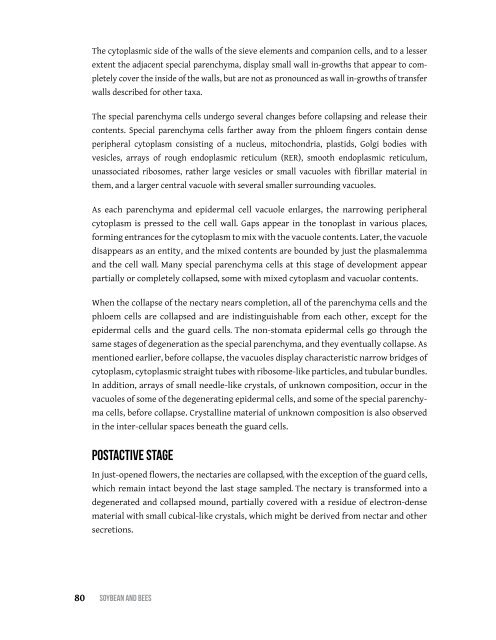Soybean and Bees
Create successful ePaper yourself
Turn your PDF publications into a flip-book with our unique Google optimized e-Paper software.
The cytoplasmic side of the walls of the sieve elements <strong>and</strong> companion cells, <strong>and</strong> to a lesser<br />
extent the adjacent special parenchyma, display small wall in-growths that appear to completely<br />
cover the inside of the walls, but are not as pronounced as wall in-growths of transfer<br />
walls described for other taxa.<br />
The special parenchyma cells undergo several changes before collapsing <strong>and</strong> release their<br />
contents. Special parenchyma cells farther away from the phloem fingers contain dense<br />
peripheral cytoplasm consisting of a nucleus, mitochondria, plastids, Golgi bodies with<br />
vesicles, arrays of rough endoplasmic reticulum (RER), smooth endoplasmic reticulum,<br />
unassociated ribosomes, rather large vesicles or small vacuoles with fibrillar material in<br />
them, <strong>and</strong> a larger central vacuole with several smaller surrounding vacuoles.<br />
As each parenchyma <strong>and</strong> epidermal cell vacuole enlarges, the narrowing peripheral<br />
cytoplasm is pressed to the cell wall. Gaps appear in the tonoplast in various places,<br />
forming entrances for the cytoplasm to mix with the vacuole contents. Later, the vacuole<br />
disappears as an entity, <strong>and</strong> the mixed contents are bounded by just the plasmalemma<br />
<strong>and</strong> the cell wall. Many special parenchyma cells at this stage of development appear<br />
partially or completely collapsed, some with mixed cytoplasm <strong>and</strong> vacuolar contents.<br />
When the collapse of the nectary nears completion, all of the parenchyma cells <strong>and</strong> the<br />
phloem cells are collapsed <strong>and</strong> are indistinguishable from each other, except for the<br />
epidermal cells <strong>and</strong> the guard cells. The non-stomata epidermal cells go through the<br />
same stages of degeneration as the special parenchyma, <strong>and</strong> they eventually collapse. As<br />
mentioned earlier, before collapse, the vacuoles display characteristic narrow bridges of<br />
cytoplasm, cytoplasmic straight tubes with ribosome-like particles, <strong>and</strong> tubular bundles.<br />
In addition, arrays of small needle-like crystals, of unknown composition, occur in the<br />
vacuoles of some of the degenerating epidermal cells, <strong>and</strong> some of the special parenchyma<br />
cells, before collapse. Crystalline material of unknown composition is also observed<br />
in the inter-cellular spaces beneath the guard cells.<br />
Postactive stage<br />
In just-opened flowers, the nectaries are collapsed, with the exception of the guard cells,<br />
which remain intact beyond the last stage sampled. The nectary is transformed into a<br />
degenerated <strong>and</strong> collapsed mound, partially covered with a residue of electron-dense<br />
material with small cubical-like crystals, which might be derived from nectar <strong>and</strong> other<br />
secretions.<br />
80 SoybeAn <strong>and</strong> bees


